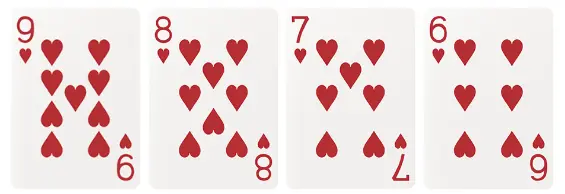
In a game of Texas Hold'em, understanding the different hand types and their rankings is key to winning. Texas Hold'em is not just a battle of strategy and skill but also a game of odds and psychology.
In just 5 minutes, learn the essential Texas Hold'em basics from hand rankings to winning odds so you can stay sharp and make smart decisions at the table.
Texas Hold'em Hand Rankings
Royal Flush

A Royal Flush is a straight flush made up of the highest cards: A, K, Q, J, and 10 of the same suit. If a tie occurs, the players split the pot, and the game is considered a draw.
Straight Flush

A Straight Flush is five consecutive cards of the same suit, such as 9, 8, 7, 6, 5 all in hearts. When two players have a straight flush, the one with the higher top card wins. If there is a tie, the players split the pot, and the game ends in a draw.
💡Pro Tip: A straight flush with A, 2, 3, 4, 5 is considered the lowest straight flush. Combinations like J, Q, K, A, 2 or Q, K, A, 2, 3 or K, 1, 2, 3, 4 do not qualify as a straight flush.
Four of a Kind

Four of a Kind means having four cards of the same rank in different suits, plus one other card known as the kicker. For example, holding four Aces is a Four of a Kind. The higher the rank of the four matching cards, the stronger the hand.
Full House

Full House is a hand that contains three cards of one rank and two cards of another rank, such as three Kings and two Sixes. When comparing two full houses, the hand with the higher-ranking three of a kind wins.
Flush

Flush is a hand where all five cards are of the same suit but not in a sequence, such as five clubs. When comparing two flushes, the hand with the highest-ranking card wins.
If both flushes have the same highest card, the second-highest card is compared, then the third, and so on until a winner is determined. If all five cards are identical in rank, the players split the pot and the game ends in a draw.
Straight

A Straight is a hand with five consecutive cards of mixed suits, such as 9, 8, 7, 6, 5 in different suits. When comparing two straights, the one with the higher top card wins. If both straights have the same value, suits are not used to break the tie. In case of a tie, the players split the pot and the game is a draw.
💡Pro Tip: A, 2, 3, 4, 5 is the lowest possible straight. Combinations like J, Q, K, A, 2 or Q, K, A, 2, 3 or K, 1, 2, 3, 4 do not qualify as valid straights.
Three of a Kind

Three of a Kind is a hand that contains three cards of the same rank in different suits, along with two unrelated cards. For example, holding three Kings is called Three of a Kind. The hand with the higher-ranking set of three wins over the lower one.
Two Pair

Two Pair is a hand that contains two cards of one rank, two cards of another different rank, and one unrelated card. For example, having two Aces and two Kings is considered Two Pair.
In Two Pair vs Two Pair, the hand with the higher top pair wins. If tied, compare the second pair, then the kicker.
If both hands have the same top pair, the second pair is compared. If both pairs are identical, the kicker decides the winner. If still tied, the pot is split and the game ends in a draw.
One Pair

One Pair is a hand that contains two cards of the same rank, such as two Kings, plus three other unmatched cards.
A higher-ranking pair beats a lower one. If both hands have the same pair, the remaining three cards are compared in descending order. If still tied, the pot is split and the game ends in a draw.
High Card

High Card is a hand that does not fit any of the above hand rankings. It has no matching ranks, no sequence, and no flush.
Texas Hold'em Hand Rankings
Texas Hold'em Hand Rankings: Royal Flush > Straight Flush > Four of a Kind > Full House > Flush > Straight > Three of a Kind > Two Pair > One Pair > High Card
The following is a breakdown of Texas Hold'em hand rankings, listed from strongest to weakest:
- Royal Flush: Consists of A, K, Q, J, and 10 of the same suit.
- Straight Flush: Five consecutive cards of the same suit.
- Four of a Kind: Four cards of the same rank plus one unrelated card.
- Full House: Three cards of one rank and two cards of another rank.
- Flush: Five cards of the same suit, not in sequence.
- Straight: Five consecutive cards of any suits. The Ace can be used as either 1 or 14.
- Three of a Kind: Three cards of the same rank and two unrelated cards.
- Two Pair: Two different pairs plus one unrelated card.
- One Pair: Two cards of the same rank and three unrelated cards.
- High Card: The hand with the highest single card when no other hand combinations are made.
Texas Hold'em Straight Rankings
In Texas Hold'em, the strength of a straight is determined by the highest card in the sequence. The strongest straight is A-K-Q-J-10, often called the "Broadway straight," while the weakest is 5-4-3-2-A, also known as the "wheel."
When two players have straights, the one with the higher top card wins. For example, 10-9-8-7-6 beats 9-8-7-6-5.
Texas Hold'em Full House Rankings
In a Full House (also known as a "boat"), the hand’s strength is first determined by the rank of the three matching cards, followed by the rank of the pair.
For example, AAA22 (three Aces and two Twos) beats KKKQQ (three Kings and two Queens). If both players have the same three of a kind, the higher-ranking pair decides the winner.
Texas Hold'em Suit Rankings
In Texas Hold'em, suits do not affect the strength of a hand. No suit is ranked higher than another. When comparing hands, suits are not used to determine the winner.
The only exception is when forming a Flush or Straight Flush, where suits are part of the hand's composition, but even then, the comparison is based on card values, not suit rankings.
Tied Hands in Texas Hold'em
1. Split Pot
When players have identical hand rankings and no cards can break the tie, the pot is split evenly among them. For example, if two players both hold a straight flush with A-K-Q-J-10 in different suits, they share the pot.
2. Kicker
In certain hands such as One Pair, Two Pair, Three of a Kind, or High Card, if the main hand is the same, the winner is determined by comparing the remaining cards, known as kickers.
If the first kicker is also tied, the next kicker is compared, and so on. If all kickers are identical, the pot is split.
3. Use of Kickers
- Flush and Straight Flush: Compare the highest card first. If tied, compare the next highest card, and so on until a winner is determined. If all relevant cards are the same, the pot is split.
- Full House: First compare the rank of the three matching cards. If they are the same, compare the rank of the pair. If both are identical, the pot is split.
- Straight: The highest card in the straight determines the winner. If both players have the exact same straight (which is rare due to different combinations), the pot is split.
4. Special Cases
If the community cards alone form the strongest possible hand and more than one player can only use those cards to make their final hand, the pot is split among them.
For example, if there is a Royal Flush on the board, all players share the pot.
When hands are of equal rank, the winner is usually determined by the kicker. If everything is exactly the same, the pot is split. This rule ensures fairness and adds depth to the game's strategy.
Texas Hold'em Hand Odds
| Hand Type | Number of Combinations | Probability |
|---|---|---|
| Royal Flush | 4 | 0.000154% |
| Straight Flush | 36 | 0.00144% |
| Four of a Kind | 624 | 0.0240% |
| Four of a Kind | 3,744 | 0.144% |
| Full House | 5,108 | 1.97% |
| Flush | 10,200 | 0.392% |
| Straight | 54,912 | 2.11% |
| Three of a Kind | 123,552 | 4.75% |
| Two Pair | 1,098,240 | 42.26% |
| High Card | 1,302,540 | 50.12% |
Texas Hold'em Starting Hand Win Rates
| Starting Hand | Win Rate |
|---|---|
| A-A | 85% |
| K-K | 82% |
| Q-Q | 79% |
| J-J | 77% |
| 10-10 | 75% |
| A-K (Suited) | 67% |
| A-Q (Suited) | 65% |
| A-J (Suited) | 64% |
| K-Q (Suited) | 63% |
| A-K (Offsuit) | 60% |
Texas Hold'em Rules
Texas Hold'em is a card game where players compete for the pot by placing bets. The objective is to win all the chips in the pot.
Texas Hold'em Game Flow
The game flow of Texas Hold'em is as follows:
- Shuffling and Dealing: The dealer shuffles the cards and deals two hole cards to each player, face down.
- Pre-Flop Betting: Players can choose to fold, check, bet, raise, or go all-in.
- The Flop: The dealer places three community cards face up in the center of the table.
- Post-Flop Betting: Players can again choose to fold, check, bet, raise, or go all-in.
- The Turn: A fourth community card is dealt face up on the table.
- Post-Turn Betting: Players can fold, check, bet, raise, or go all-in.
- The River: A fifth and final community card is dealt face up.
- Post-River Betting: Players can fold, check, bet, raise, or go all-in.
- Showdown: If two or more players remain after the river betting round, a showdown occurs. Players reveal their hole cards, and the best hand wins the pot.
Texas Hold'em Betting Rules
Limit Texas Hold'em is a variant of Texas Hold'em where each betting round allows a maximum of four bets: a bet, a raise, a re-raise, and a final raise.
Each round permits only one bet and up to three raises.
Recommended Online Texas Hold'em Sites
When choosing an online Texas Hold'em platform, here are some player-recommended options. Each site offers unique features to suit different types of players:
- PokerStars: One of the largest online poker platforms in the world. It offers a wide range of Texas Hold'em games and major tournaments, making it suitable for players of all skill levels.
- DB Live Casino: Known for its user-friendly interface and a rich selection of live dealer games. It features various live poker games and regular tournaments.
- Golden Chess Poker: A poker game featured in the Fuyou Entertainment City platform. It offers a variety of electronic table poker games with detailed visuals, ideal for beginners.
Conclusion: Key Points of Texas Hold'em Hand Rankings
Texas Hold'em is a strategic and psychological poker game where understanding hand rankings is crucial to winning.
From highest to lowest, key hands include: Royal Flush, Straight Flush, Four of a Kind, Full House, Flush, Straight, Three of a Kind, Two Pair, One Pair, and High Card. Knowing how ties are resolved and the odds of each hand is essential for smart gameplay.
Understanding starting hand win rates helps players make better early-game decisions. As the game progresses, adapting to community cards and opponent behavior is vital.





